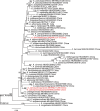Morphology, multilocus phylogeny, and toxin analysis reveal two new species of Amanita section Amanita (Amanitaceae) from China
- PMID: 40530239
- PMCID: PMC12171729
- DOI: 10.3897/mycokeys.118.141080
Morphology, multilocus phylogeny, and toxin analysis reveal two new species of Amanita section Amanita (Amanitaceae) from China
Abstract
Globally, many species of Amanitasect.Amanita (Amanitaceae, Agaricales) cause poisoning after consumption. Amanitaflavomelleiceps sp. nov. and Amanitaparvisychnopyramis sp. nov., two new species of A.sectionAmanita from China, are described here. Morphology and molecular phylogenetic analyses based on five genes (ITS, nrLSU, RPB2, TEF1-α, and TUB2) revealed these two taxa as distinct species. Amanitaflavomelleiceps sp. nov. is characterized by a yellowish-to-yellow pileus covered by verrucose volval remnants; a subglobose basal bulb with shortly limbate; subglobose to broadly ellipsoid, inamyloid basidiospores. Amanitaparvisychnopyramis sp. nov. is characterized by a brownish pileus covered by subconical volval remnants; an ovate basal bulb with a cream limbate; and subglobose-to-broadly ellipsoid, inamyloid basidiospores. Screening for the most notorious toxins by liquid chromatography tandem mass spectrometry (LC-MS/MS) revealed the presence of ibotenic acid (IBO) and muscimol (MUS) in A.parvisychnopyramis and the absence of these toxins in A.flavomelleiceps.
Keywords: Ibotenic acid; morphology; muscimol; taxonomy.
Yu-Ting Su, Fei Xu, Ping Zhang, Peng-Tao Deng, Meng-Meng Lai, Zuo-Hong Chen.
Conflict of interest statement
The authors have declared that no competing interests exist.
Figures








Similar articles
-
Morphology, Multilocus Phylogeny, and Toxin Analysis Reveal Amanita albolimbata, the First Lethal Amanita Species From Benin, West Africa.Front Microbiol. 2020 Nov 20;11:599047. doi: 10.3389/fmicb.2020.599047. eCollection 2020. Front Microbiol. 2020. PMID: 33329489 Free PMC article.
-
Three new species of Sanguinoderma (Ganodermataceae, Basidiomycota) from Southwest China revealed by morphology and phylogenetic analysis.MycoKeys. 2025 Jun 9;118:245-265. doi: 10.3897/mycokeys.118.152086. eCollection 2025. MycoKeys. 2025. PMID: 40530240 Free PMC article.
-
Determination of ibotenic acid and muscimol in species of the genus Amanita section Amanita from China.Toxicon. 2023 Sep;233:107257. doi: 10.1016/j.toxicon.2023.107257. Epub 2023 Aug 21. Toxicon. 2023. PMID: 37611670
-
Assessing the comparative effects of interventions in COPD: a tutorial on network meta-analysis for clinicians.Respir Res. 2024 Dec 21;25(1):438. doi: 10.1186/s12931-024-03056-x. Respir Res. 2024. PMID: 39709425 Free PMC article. Review.
-
Olaparib Monotherapy or in Combination with Abiraterone for the Treatment of Patients with Metastatic Castration-Resistant Prostate Cancer (mCRPC) and a BRCA Mutation.Target Oncol. 2025 May;20(3):445-466. doi: 10.1007/s11523-025-01146-4. Epub 2025 May 21. Target Oncol. 2025. PMID: 40397306 Free PMC article. Review.
References
-
- Ariyawansa HA, Hyde KD, Jayasiri SC, Buyck B, Chethana KWT, Dai DQ, Dai YC, Daranagama DA, Jayawardena RS, Lücking R, Ghobad-Nejhad M, Niskanen T, Thambugala KM, Voigt K, Zhao RL, Li G-J, Doilom M, Boonmee S, Yang ZL, Cai Q, Cui Y-Y, Bahkali AH, Chen J, Cui BK, Chen JJ, Dayarathne MC, Dissanayake AJ, Ekanayaka AH, Hashimoto A, Hongsanan S, Jones EBG, Larsson E, Li WJ, Li Q-R, Liu JK, Luo ZL, Maharachchikumbura SSN, Mapook A, McKenzie EHC, Norphanphoun C, Konta S, Pang KL, Perera RH, Phookamsak R, Phukhamsakda C, Pinruan U, Randrianjohany E, Singtripop C, Tanaka K, Tian CM, Tibpromma S, Abdel-Wahab MA, Wanasinghe DN, Wijayawardene NN, Zhang J-F, Zhang H, Abdel-Aziz FA, Wedin M, Westberg M, Ammirati JF, Bulgakov TS, Lima DX, Callaghan TM, Callac P, Chang C-H, Coca LF, DalForno M, Dollhofer V, Fliegerová K, Greiner K, Griffith GW, Ho H-M, Hofstetter V, Jeewon R, Kang JC, Wen T-C, Kirk PM, Kytövuori I, Lawrey JD, Xing J, Li H, Liu ZY, Liu XZ, Liimatainen K, Lumbsch HT, Matsumura M, Moncada B, Nuankaew S, Parnmen S, de Azevedo Santiago ALCM, Sommai S, Song Y, de Souza CAF, de Souza-Motta CM, Su HY, Suetrong S, Wang Y, Wei S-F, Wen TC, Yuan HS, Zhou LW, Réblová M, Fournier J, Camporesi E, Luangsa-ard JJ, Tasanathai K, Khonsanit A, Thanakitpipattana D, Somrithipol S, Diederich P, Millanes AM, Common RS, Stadler M, Yan JY, Li X, Lee HW, Nguyen TTT, Lee HB, Battistin E, Marsico O, Vizzini A, Vila J, Ercole E, Eberhardt U, Simonini G, Wen H-A, Chen X-H, Miettinen O, Spirin V, Hernawati (2015) Fungal diversity notes 111–252—Taxonomic and phylogenetic contributions to fungal taxa. Fungal Diversity 75(1): 27–274. 10.1007/s13225-015-0346-5 - DOI
-
- Bas C. (1969) Morphology and subdivision of Amanita and a monograph of its section Lepidella. Molecular Phylogeny and Evolution of Fungi 5(4): 285–573. https://repository.naturalis.nl/pub/531781
-
- Bhatt RP, Mehmood T, Uniyal P, Singh U. (2017) Six new records of genus Amanita (Amanitaceae) from Uttarakhand, India. Current Research in Environmental & Applied Mycology 7(3): 161–182. 10.5943/cream/7/3/3 - DOI
LinkOut - more resources
Full Text Sources
